
In 1923 the London Brighton and South Coast Railway along with the other two railway
companies serving the south of England, The London and South Western and the South
Eastern and Chatham were amalgamated under the 1921 Grouping Act to form the Southern
Railway.
Its new Chairman was Sir Herbert Walker and one of his first undertakings was to modernise the network and part of this involved electrification of the suburban system around London and also electrification of the countries first main line between London and Brighton.
Work commenced in stages between Coulsdon North (the furthest point of the suburban
system) and Three Bridges being completed on Sunday 17th July 1932 and finally on to
Brighton ready for the full commencement of electric services on Sunday 1st January 1933.
Work on the 60 mile extension to Lewes, Eastbourne and Hastings was begun at the end of
1933 and public electric service was inaugurated on Sunday 7th July, 1935, when a total of
444 route and 1,156 track miles was operated electrically by the Southern Railway.
The London to Brighton electrification brought many redundancies amongst the grades
within the Brighton locomotive department, locomotive yard workers and signal-men. The
attitude amongst loco-men had changed as they saw electrification take away the certainty
they had that Enginemen would always be needed to drive steam engines and that becoming a Motorman did not have the same “prestige” as being an Enginemen. The passion and pride
that they once had for their craft was slowly diminishing and this become noticeable in their
pride for their locomotives. Loco-men now began to see their livelihoods under threat. This
was a scene that was repeated across the network as electrification slowly spread out to
various points through out the company With the electrification of the railway line to
Brighton and West Worthing in 1932 by the then Southern Railway there was a need to open
two new Motormen Depots at Brighton and West Worthing. This being the furthest point of
electrification along the West Coast from Brighton at the time.
The reason for this was because a Steam Engine Driver (Engineman) and an Electric
Multiple Unit Driver (Motorman) were separate Grades on the Southern Railway and then
the Southern Region of British Railways until 1961.
Many Enginemen transferred into the new Motormen’s depots because of the job security that was on offer. The loco hauled passenger traffic was slowly being replaced by new faster
electric trains, this was enabling the Southern Railway to offer a more frequent, reliable and
a standard timetabled train service. Some towns receiving an hourly service during the day
rather than a hand full of trains as before.
Many of the junior Enginemen also faced little choice other than to take up this move
otherwise they could well be faced with the prospect of being made surplus to requirements.
Some Passed Men (a grade of Senior Fireman who had also been passed as an Enginemen
when required) also saw this as their opportunity to get promoted into the Motorman’s grade
and higher wages, rather than waiting many years to gain promotion to an Engineman’s
position. This being because Passed Men were only paid an Enginemen’s rate of pay when
they were required to undertake Enginemen’s duties. As a Motorman they would always be
paid the higher rate and also guaranteeing them a 50% ratio of Sunday working.
Although all Motormen had originally progressed from Enginemen and Firemen before
transferring to Motormen’s Depots and some Steam Depots including Brighton had “Dual
Links” where certain Enginemen worked both Steam and Electric Multiple Unit Trains. At all Motormen’s depots there where only diagrammed running work with no spare capacity to
cover for leave or sickness. This worked was to be covered by the dual link drivers. At
Brighton once an Enginemen had opted to go into this link, this meant that he would
eventually to transfer into the Motormen’s depot on a permanent basis at either Brighton or
West Worthing. As being a Motorman was a separate Grade to an Engineman there was no
arrangement that would allow Motormen to transfer back into the Engineman grade and
therefore he was to remain being a Motorman for the rest of his working life. With the end of the Motormen’s grade in 1961 any Engineman who had been appointed to the position of
Motorman would be protected under an agreement known as L211 Men. This gave the
Motorman the protection that they not to have to work on any other form of traction unless
they decided to choose otherwise.
This agreement played a major apart in later years at Brighton with the amalgamation of
both the E.M.U.T. and Mixed Traction depots.
Motormen deemed themselves as superior to steam men, despite being on the same pay and Brighton line men in particular, thought they were the "cat's whiskers". In return, Motormen were referred to as "tram drivers" by their steam counterparts, had proper jackets with the pocket flaps. Their soft topped cap had a black badge with "Motorman" stitched in green while "leading" motormen had yellow stitches. Some modified their caps giving it a chin strap held on with a button each side. Others would stuff their caps with paper to keep them on.
The leading motorman would open the weekly notices and pin them up. He would also send off the "daily returns", listing the units worked and the timings. For this he would get around an extra shilling per day. At depot where there was a supervisor there was no leading motorman and eventually motorman answered to their supervisors only.
Over the next few pages and sub pages will feature the events leading up to electrification of
the Brighton Main Line from a A.S.L.E.&F. prospective who were working the various depots on the Brighton section of the Southern Railway.
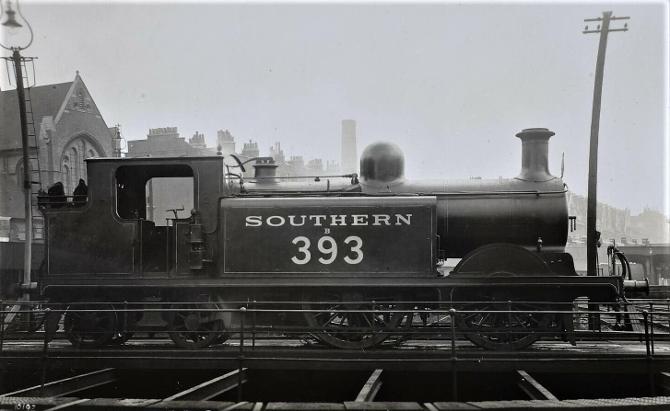
Brighton Fireman, G.E. Plaine transferred to New Cross Gate Loco as a fireman. He was one of a large number of Brighton Enginemen who were made redundant owing to the electrification of the Brighton main line in 1933. G.E. Plaine became Passed Man at New Cross Gate, and on the 25th August 1940, and later transferred back to Brighton Loco.
THREE BRIDGES LOCOMOTIVE SHED
During the Southern Railway era there were so many changes in the workings it would take far too long to list them all. The allocation of engines at Three Bridges grew to a maximum of 33 engines in 1933, for 16 turns. The London turns grew to a maximum of four in 1932, but they varied over the years. The 8.35 a.m. from Forest Row remained a Three Bridges turn throughout, as did the 8.57 a.m. Tunbridge Wells to London via Three Bridges, until it was withdrawn in 1932. The 8.08 a.m. Lewes to London Bridge via East Grinstead was Three Bridges work, except for 1925 to 1927, when it became a Redhill working, until 1933 when the Brighton shed took over the work. Other service taking Three Bridges engines to London were 10.50 a.m. and 6.25 p.m. Tunbridge Wells West to London Bridge, 1.40 p.m. Horsham to London Bridge, 4.20 p.m. Horsham to London Victoria (both via the Back Road), and 3.35 p.m. Haywards Heath to London Bridge via East Grinstead.
In the summer of 1930 for the first time a regular Sunday passenger turn was put on working to Brighton and back to Three Bridges in the morning, then in the evening leaving Three Bridges at 6.52 p.m. for London Bridge returning via Oxted and East Grinstead. This ceased in 1932 and there was no Sunday work until 1938, when a news and milk working was put on from Three Bridges to Billingshurst and back. This absence of Sunday work seems to have remained up until its final closure.
Over the years Horsham and Three Bridges sheds were generally managed as one entity. In the L.B.S.C.R. days the Horsham allocation was generous to provide spares for both sheds. For most of the time Horsham remained the principal shed, but in later the mantle passed to Three Bridges. Both sheds had one thing in common, during the lifetime of the L.B.S.C.R.; they had little or no Sunday work. The only Sunday work at Three Bridges of a regular nature was the provision of a “Stand-by engine” on Sundays in summer, a practice which the Southern Railway carried on until electrification in 1933. For a time a Class B1 was allocated and covered this duty, it also worked week day excursions, particularly at the beginning and the end of the summer season, Cooks, Restall and the National Sunday League ran excursions from London down to the coast which divided at Three Bridges for e.g. Brighton/ Bognor, Brighton/Eastbourne, and the B1 would also take over the detached portion.
There were fewer return services and prior to suburban electrification some of the Three Bridges engines worked trains to Coulsdon North, and the running light engine back to the Bridges. Up to 1933 the engine of the 8.08 a.m. ex-Lewes returned on Mondays to Fridays as far as Redhill midday goods from Bricklayers to Reading. On Saturdays it worked the 12.40 p.m. London Bridge to Gomshall and back to Redhill thence each day light engine to Redhill Goods for a fright trip to Three Bridges. Other return workings were 12.50 (N9) Battersea Yard to Three Bridges, 12.40 p.m. (SO) Victoria to Horsham, and the 12.22 a.m. (NM) Bricklayers Arms to Reading (as far as Redhill) thence the 2.40 a.m. goods to Three Bridges.
Up to 1933 the London turns were work by Classes E4 or E5 Radials, but the Brighton electrification released some Class I3s, which worked some of the turs until they were banned from the Three Bridges to Ashurst Junction section, and some I1/xs were drafted in. The I3s returned in 1942.
Other passenger turns during the Southern Railway era took Three Bridges engines on to the Uckfield line, Steyning line, and Dyke Branch (from 1924), to Cranliegh and Guildford (from 1926), to Seaford and Tonbridge in 1929, to Redhill via Tonbridge in 1930 and in 1931 there was working over the ‘Cuckoo line’.
Although rail motor trains were frequent visitor to Three Bridges, none were based there except for a six month period January to July 1933 when duty 660, rostered for a Class D1/m ran light to Haywards Heath for the 6.40 a.m. to Oxted and after visiting Tunbridge Wells, Brighton, Seaford, and Uckfield, finishing with the 7.36 p.m. Horsted Keynes to Haywards Heath and then light engine back to Three Bridges. The next motor workings based on Three Bridges, seem to have been in 1955 when some Class M7’s were allocated for working between Three Bridges, East Grinstead, Tunbridge Wells West and Oxted.
Goods working over this period, apart from the cross London workings already mentioned, included two Steyning “Roundabouts”, one in each direction, local trips to East Grinstead, Horsham, Guildford, Tunbridge Wells and Redhill. After the Eastbourne line electrification in 1935, Three Bridges had some goods and van workings to both Eastbourne and Newhaven.
The Three Bridges Yard pilot was a Class “E1” lasted well into the British Railways era and was supplanted first by a Class “E4” and later by a 350 h.p. diesel shunter locomotive. The Redhill Goods shunter was transferred to Redhill shed in 1927.
THREE BRIDGES LOCOMOTIVE SHED
During the Southern Railway era there were so many changes in the workings it would take far too long to list them all. The allocation of engines at Three Bridges grew to a maximum of 33 engines in 1933, for 16 turns. The London turns grew to a maximum of four in 1932, but they varied over the years. The 8.35 a.m. from Forest Row remained a Three Bridges turn throughout, as did the 8.57 a.m. Tunbridge Wells to London via Three Bridges, until it was withdrawn in 1932. The 8.08 a.m. Lewes to London Bridge via East Grinstead was Three Bridges work, except for 1925 to 1927, when it became a Redhill working, until 1933 when the Brighton shed took over the work. Other service taking Three Bridges engines to London were 10.50 a.m. and 6.25 p.m. Tunbridge Wells West to London Bridge, 1.40 p.m. Horsham to London Bridge, 4.20 p.m. Horsham to London Victoria (both via the Back Road), and 3.35 p.m. Haywards Heath to London Bridge via East Grinstead.
In the summer of 1930 for the first time a regular Sunday passenger turn was put on working to Brighton and back to Three Bridges in the morning, then in the evening leaving Three Bridges at 6.52 p.m. for London Bridge returning via Oxted and East Grinstead. This ceased in 1932 and there was no Sunday work until 1938, when a news and milk working was put on from Three Bridges to Billingshurst and back. This absence of Sunday work seems to have remained up until its final closure.
Over the years Horsham and Three Bridges sheds were generally managed as one entity. In the L.B.S.C.R. days the Horsham allocation was generous to provide spares for both sheds. For most of the time Horsham remained the principal shed, but in later the mantle passed to Three Bridges. Both sheds had one thing in common, during the lifetime of the L.B.S.C.R.; they had little or no Sunday work. The only Sunday work at Three Bridges of a regular nature was the provision of a “Stand-by engine” on Sundays in summer, a practice which the Southern Railway carried on until electrification in 1933. For a time a Class B1 was allocated and covered this duty, it also worked week day excursions, particularly at the beginning and the end of the summer season, Cooks, Restall and the National Sunday League ran excursions from London down to the coast which divided at Three Bridges for e.g. Brighton/ Bognor, Brighton/Eastbourne, and the B1 would also take over the detached portion.
There were fewer return services and prior to suburban electrification some of the Three Bridges engines worked trains to Coulsdon North, and the running light engine back to the Bridges. Up to 1933 the engine of the 8.08 a.m. ex-Lewes returned on Mondays to Fridays as far as Redhill midday goods from Bricklayers to Reading. On Saturdays it worked the 12.40 p.m. London Bridge to Gomshall and back to Redhill thence each day light engine to Redhill Goods for a fright trip to Three Bridges. Other return workings were 12.50 (N9) Battersea Yard to Three Bridges, 12.40 p.m. (SO) Victoria to Horsham, and the 12.22 a.m. (NM) Bricklayers Arms to Reading (as far as Redhill) thence the 2.40 a.m. goods to Three Bridges.
Up to 1933 the London turns were work by Classes E4 or E5 Radials, but the Brighton electrification released some Class I3s, which worked some of the turs until they were banned from the Three Bridges to Ashurst Junction section, and some I1/xs were drafted in. The I3s returned in 1942.
Other passenger turns during the Southern Railway era took Three Bridges engines on to the Uckfield line, Steyning line, and Dyke Branch (from 1924), to Cranliegh and Guildford (from 1926), to Seaford and Tonbridge in 1929, to Redhill via Tonbridge in 1930 and in 1931 there was working over the ‘Cuckoo line’.
Although rail motor trains were frequent visitor to Three Bridges, none were based there except for a six month period January to July 1933 when duty 660, rostered for a Class D1/m ran light to Haywards Heath for the 6.40 a.m. to Oxted and after visiting Tunbridge Wells, Brighton, Seaford, and Uckfield, finishing with the 7.36 p.m. Horsted Keynes to Haywards Heath and then light engine back to Three Bridges. The next motor workings based on Three Bridges, seem to have been in 1955 when some Class M7’s were allocated for working between Three Bridges, East Grinstead, Tunbridge Wells West and Oxted.
Goods working over this period, apart from the cross London workings already mentioned, included two Steyning “Roundabouts”, one in each direction, local trips to East Grinstead, Horsham, Guildford, Tunbridge Wells and Redhill. After the Eastbourne line electrification in 1935, Three Bridges had some goods and van workings to both Eastbourne and Newhaven.
The Three Bridges Yard pilot was a Class “E1” lasted well into the British Railways era and was supplanted first by a Class “E4” and later by a 350 h.p. diesel shunter locomotive. The Redhill Goods shunter was transferred to Redhill shed in 1927.
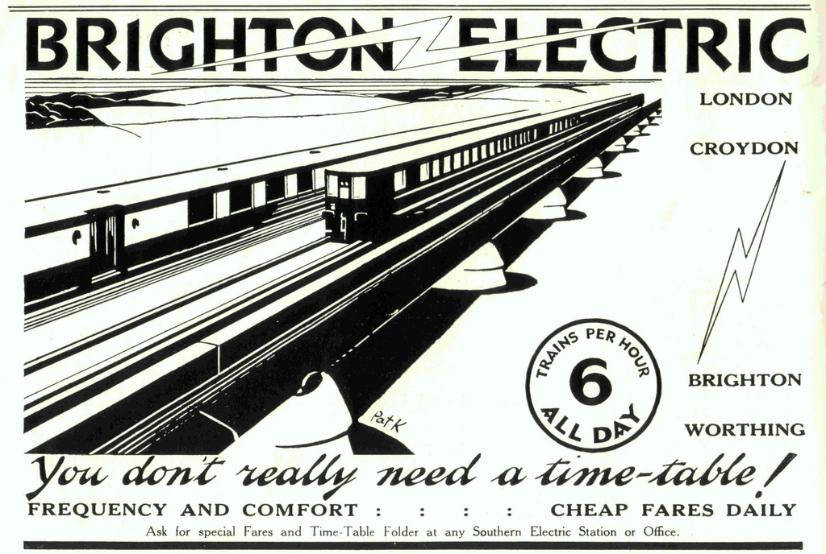
The 1st January 1933, at Victoria station with the inaugural
“Electric Southern Belle”
The forerunner of the "Brighton Belle"
PHOTOGRAPHER UNKNOWN
The new electric service provided for a sixty minute schedule of express trains between
London and Brighton. This was actually the same timing as that of the ‘Sunday Pullman
Limited' of 1898 and only five minutes faster than the sixty five schedule achieved in 1858.
Much faster times wee of course possible by electric trains and on trial runs the times were in the region of three quarters of an hour were recorded several times. The advantage of electric service was to provide a more frequent and punctual service rather than excessive speed, which traffic conditions might not always allow.
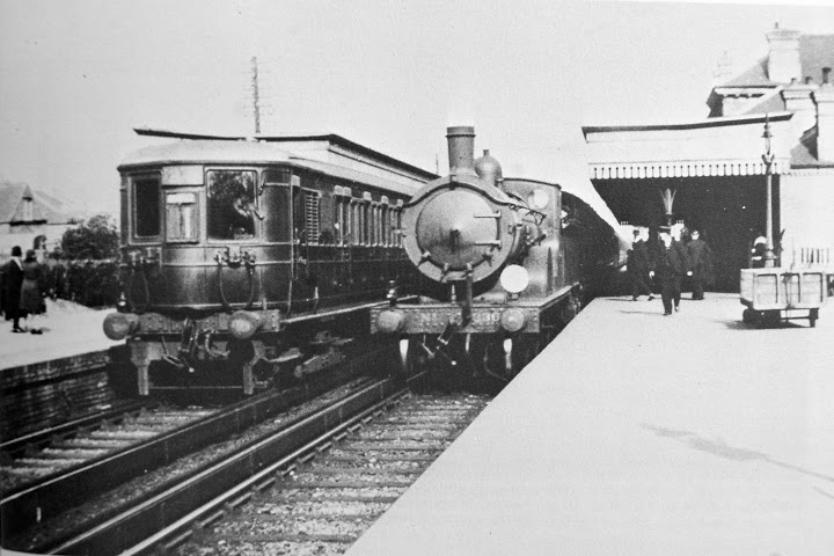
PHOTOGRAPHER UNKNOWN
West Worthing Station, the terminating point of electrification
from London and Brighton 1933 - 1938.
Railway accident on the
Southern Railway
Brighton Section
COLLISION AT THREE BRIDGES INVOLVING
BRIGHTON DRIVER A.C. BATCHELOR
ON THE 28th JANUARY 1933
The 11.30 p.m. (steam) freight train, Norwood to West Worthing worked by Brighton driver A. C. Batchelor and his fireman C. Small, had been brought to a stand at the down slow home signals of Three Bridges signal box and was waiting to cross over front the down local to the down through line after the passage of an express on the latter line, Just as it was starting ahead after the signal had been cleared for this movement, it was run into from the rear by the 11.46 pm. electric passenger train from Victoria to Three Bridges worked by motorman T. E. Hart, which was following it on the same (Down slow) line.
The guard of the freight train and the motorman of the electric train were seriously injured;
but none of the five passengers in the electric train complained of injury. Assistance reached
the site of the accident from Three Bridges station about 12 minutes after it occurred, and a
doctor was on the spot within about half an hour. But, owing to the difficulty of extricating
them from the wreckage of the motor coach and brake van, which had to be cut apart with
oxy-acetylene torches to release them, the injured guard was not reached till about 2.0 a.m.,
and the motorman not till about 3.30 am., though everything possible was done for them.
There was fortunately no fire
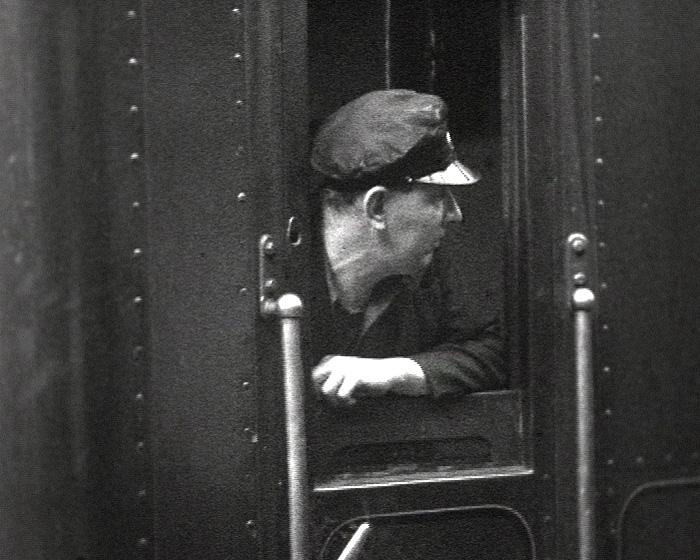
LOCOMOTIVE JOURNAL
MARCH (?)1933
BRIGHTON BRANCH
Having to some extent got over the wave of redundancy which swept over Brighton at the beginning of the year, owing to the advent of electrification, we are now endeavouring to put our house in order with what is left. The L.D.C. have had a very trying time with the redundant firemen and cleaners and must be congratulated on the way they negotiated the various problems have presented themselves since January 1st 1933, although their in that respect is not finished yet.
At our Branch meeting on Sunday, February 19th, a question was raised about the steam men on loan to the electric depot, for week-end duty, working their booked turns on Sundays in the steam depot, and when off duty from steam are at work in the electric dept. on Sundays. There was a long discussion on this subject several points of view being put forward, after which Bro. Lewery was elected the accredited representative of the motormen until they have elected their L.D.C. to deal with this and other matters arising, and where necessary, in conjunction with our own L.D.C.
It is most noticeable that at the last two or three meetings there has been a smaller attendance of members, prominent members of the branch now transferred to the electric dept. are conspicuous by their absence, and I urgently appeal to all members of both depts. to attend all meetings when off duty, and assist in clearing up some of the problems we shall be faced with during the year.
At about the time of this report is in the hands of the readers, we shall have made final arrangements for the annual dinner which takes place on Good Friday, and we are looking forward to the good time we shall have with Bro. Barton Wild, who has promised to attend. All those wishing to attend and who have not sent in their names or applied for the tickets should do so at once.
CHAIRMAN.
[Bravo ! Brighton.that’s the way to face difficulties. – ED.]
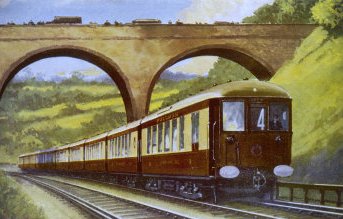
POSTCARD
Railway accident on the
Southern Railway
Brighton Section
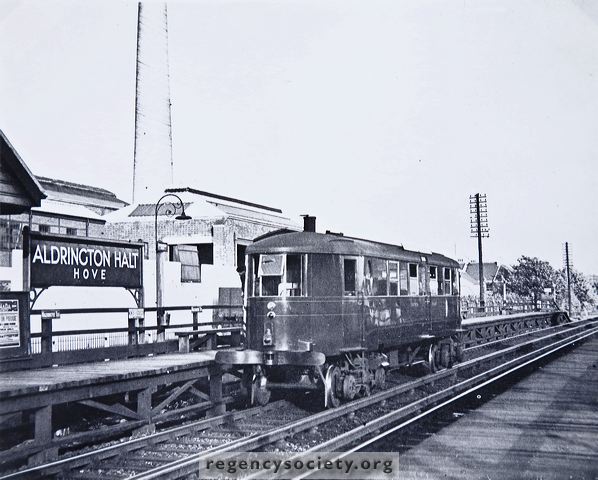
LOCOMOTIVE JOURNAL
MAY (?) 1933
BRIGHTON BRANCH
Since my last report we have had two meetings, the first on March 19th, from which there is very little to report. The ordinary business was followed by a short report from Bro. Lewery of a meeting held by the motormen to discuss items of importance concerning that department, and which is to be followed by another meeting at a later date.
The second meeting was held on April 22nd, at which I am sorry to say the attendance was fair. The chief items of interest centred around the T.U.C. Conference to be held in Brighton during September, the matter being referred to the branch committee for their recommendations as to what should be done for the delegates attending the Conference during the week.
I want to draw the attention of the members to the question of the cleaners. As is known, 45 have recently been transferred, leaving 14, 8 of whom are regularly used up on other work, leaving 6 to cover the 24 hours for other emergencies, the result of which is known to all. I understand there is some discontent amongst some members over Sunday work. Well roll up at the next branch meeting and let us know the complaints so that they can be dealt with; the L.D.C. are waiting so come along and keep them busy. A report of our Good Friday will be given in the next issue.
CHAIRMAN.
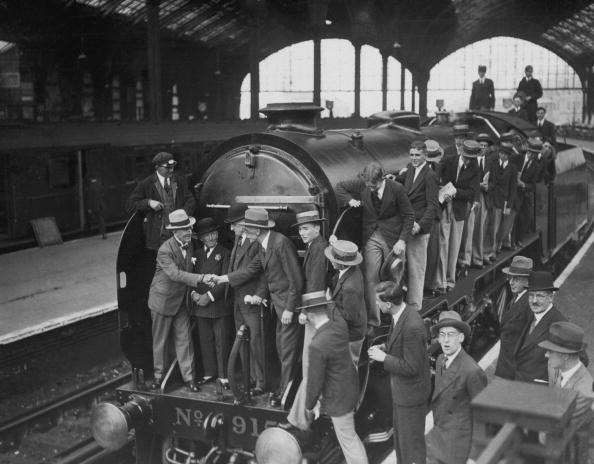
POSTCARD
The naming ceremony of Maunsell’s Schools Class Locomotive No.915 ‘Brighton’
(V Class) at Brighton Station in 1933
LOCOMOTIVE JOURNAL
1933
BRIGHTON BRANCH
On April 26th we had an American style tea party to celebrate our eighth birthday, for which
every member brought something. Our Secretary made and gave an iced cake, with eight
candles, which was a great surprise. One member, who was lucky enough to win two first
prizes at cake making in the Co-operative Exhibition, gave us a similar cake to be raffled.
We had a good tuck-in, and what was over was sold for the funds. Another member kindly
brought a gramophone. Everyone had a good time. We are having our real birthday treat on
May 30th, when we are paying a visit to “Margaret McMillan’s Home” and having a tea in London. We are not making much progress as far as membership is concerned, but we hope to get more, when the wives and daughters of our men’s Society read of the nice times we have. All may be sure of a hearty welcome.
M.E. LEWERY
CHAIRMAN
PHOTOGRAPHER UNKNOWN
Above Motorman H.G. Pepperell who was one of the first Leading Motorman at West
Worthing and become a member of A.S.L.E.F in October 1933, he also was branch
Leading Motorman/Driver was responsible for posting altered diagrams, weekly roster
and various at their depot owing to the depot having no Foreman Motorman. The
leading Motorman/Driver would received an allowance for such duties and was
normally given to the senior Motorman/Driver on each of the two shifts.
This practice still continues at certain depots within various railway companies
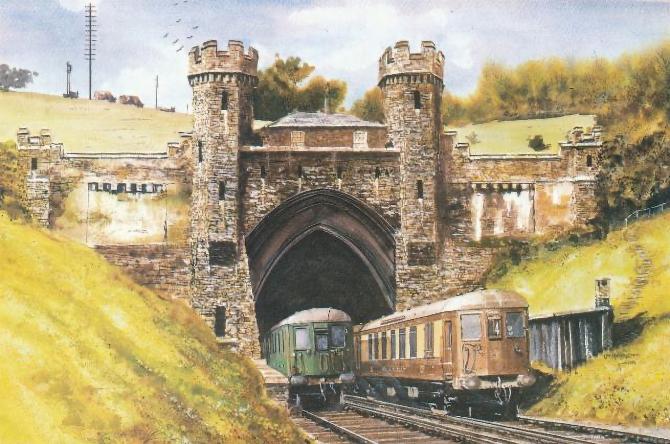
Whit-Monday 5th June 1933
In the course of the homeward rush from the seaside on Whit-Monday, 5th June, there were several achievements on the part of the Southern Railway calling for attention. At Brighton a special control tower was installed and brought into use about 4 p.m., its object being to direct passengers to the various platforms and trains, Between 5 p.m. and 10 p.m. no fewer than 107 trains left Brighton Central Station, carrying 75,000 passengers, this was due to the combination of good weather and improved travelling facilities in a great increase of passenger traffic during the Whitsun recesses. On the average, therefore, a train departed every three minutes— or slightly less—throughout the five hour period, and each train carried on an average just over 700 passengers—15,000 an hour. The great bulk of this traffic was for London or beyond, and had to be carried over the main line, which has only the one up track as far as Balcombe Tunnel box—19 miles—and in addition to the trains from Brighton there were those from Worthing and Hove also passing over almost the whole of this distance. More noteworthy still is the fact that from Keymer Junction to Balcombe Tunnel there were also the Hastings, Bexhill, Eastbourne and Seaford trains to be accommodated by the single up road in addition to those from Brighton and Worthing. Actually, between Keymer Junction and Haywards Heath the up trains moving over this road were : between 7 and 8 p.m., 13 trains ; between 8 and 9 p.m., 16 ; between 9 and 10 p.m., 18 ; and between 10 and 11 p.m., 14 trains, the greatest density being one every 3.3 minutes throughout the hour.
Only by the employment of automatic colour-light signalling, and of very heavy electric trains for the most part, could this traffic be moved within so short a period.
During the whole holiday period no less than 129,165 passengers were conveyed to Brighton, mainly by electric trains. This represents an increase of 75 per cent, over last year. On Whit-Sunday the number of people carried to Brighton showed an increase of 174 per cent, over last Whit-Sunday, while on Whit-Monday the increase was 68 per cent.
PHOTOGRAPHER UNKNOWN
One of Brighton's No.2 Branch's earliest branch members
Railway accidents on the
Southern Railway
Brighton Section